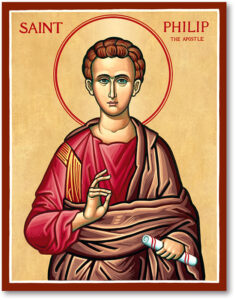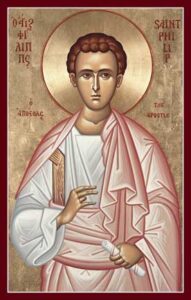Apostle St Philip – An Apostle with a Missionary Zeal – Nov 14

Philip is another of the apostles who has been rescued from the oblivion of the fourth Gospel. The first three Gospels record nothing about him except his name. In the fourth Gospel Philip figures most prominently and becomes a person and a personality. Like the brothers, Peter and Andrew, Philip (Gk. Philippos– lover of horses) came from Bethsaida in Galilee (Jn. 1: 44), and the likelihood is that he too was a fisherman. Philip is listed fifth in the three Gospel lists (Matthew 10:2-4, Mark 3:14-19, Luke 6:13-16) and Acts 1:13-16. He was also among those who surrounded John, the Baptist. Jesus met Philip and called him to His Apostolate with the words “Follow Me”. Philip obeyed to the call, and a little later brought Nathaniel as a new disciple (Jn. 1: 43-45). Philip makes four appearances in the fourth Gospel and each appearance adds to our knowledge of him.
Philip responds to Jesus right away and follows Him. St. Philip is considered as a disciple of unquestioned devotion and unchallenged faith. He had a profound depth of knowledge of the Holy Scripture, and rightly discerning the meaning of the Old Testament prophecies, he awaited the coming of the Messiah. He studied the law and prophecies and so he said to Nathaniel “We found the Messiah about him Moses wrote in the Law and the prophets, Jesus” (Jn. 1: 45).
After his call by Jesus, Philip’s first action was to find Nathaniel and to tell him of the Jesus, whom he discovered and whom Jesus found. He told Nathaniel that they had found Him of whom Moses and the prophets wrote. Even though Nathaniel was skeptical Philip did not argue but answered “Come and see” (Jn. 1: 45-46). This incident tells us that Philip had the real missionary instinct. The moment he found Jesus; he was determined to share Christ with others. He did not want to sink down in an argument, but he wanted Nathaniel to also have the firsthand knowledge of Christ. So, we can say that Philip was responsible for leading the Nathaniel to the Lord by sharing the truth of the gospel.
The next time we meet Philip is at the miraculous feeding of the 5000 (Jn. 6: 5-7). Jesus addresses the question “whence shall we buy bread that we may eat”? And Philip answers “two hundred penny (eight months wages) worth of bread is not sufficient for them that every one of them may take a little”. Probably because he was already calculating in his own mind how to feed this multitude. This reply shows that Philip did have a warm heart but did not know how it could be possible done. Philip like many of us had a vivid sense of the impossible that he had yet to learn that little is much in the hand of Christ and with God everything is possible.
Again, we meet Philip in the last days of Jesus’ life. Certain Greeks came with a request to see Jesus (Jn. 12: 21-23). Philip’s reaction was to go to Andrew and to tell him. Philip was a man who referred this to another person, before he took an important decision. The last time, we meet Philip is in the Upper Room (Jn. 14: 8-9). Jesus was talking about the Father and how He was going to His Father. Philip asked “Lord, show us the Father and that will suffice us“. Philip received what we might say the greatest answer for all of us. “He who has seen Me has seen My Father“. Philip was not a person who bottled up and restrained his questioning mind. He was not afraid or ashamed to take his problem to Jesus. He took his question to Jesus and he learned the greatest and the central truth of Christian religion: ‘If we want to see how God looks, we must look at Jesus’.
All these episodes furnish a consistent character sketch of Philip as a naive, shy, sober-minded person, pragmatic and practical, with a missionary zeal. No additional characteristics are given in the New Testament, except being mentioned as a member of the Apostolic College. (Acts 1: 13). It is said that after the Ascension of the Lord, the Apostle preached the Word of God in Galilee, accompanying his preaching with miracles. He restored to life a dead infant in the arms of its mother. From Galilee he went to Greece.

The most convincing tradition of Philip’s later life is that he preached in Asia Minor, Greece and Phrygia. In Greece, the Jews wanted to kill him, but the Lord saved him by His mighty miracles. Thus, a Jewish high priest that rushed at Philip to beat him was suddenly blinded and turned completely black. Many other miracles were manifested, especially the healing of the sick, by which many pagans believed in Christ.
The apocryphal “Acts of Philip’ refer to Philips death in Hieropolis. He had come to Hieropolis and found people worshipping a great snake. God’s Apostle destroyed the snake with prayer as though with a spear. Philip preached with great success, but this aroused, the hatred and enmity of the proconsul, whose wife was converted to Christianity. St Philip is believed to have worked for the Gospel with John the Theologian, his own sister Mariamne and the Apostle Bartholomew. Many other wonders were wrought, especially the healing of the sick, by which many of the pagans came to faith in Christ. Philip was stripped, pierced in ankles and thighs and hung head downwards. Before his death he requested that his body be wrapped in Papyrus and not in linen as he was not worthy that even his body should be like that of Christ. So Philip died faithful unto death. The legends are fairly unanimous that Philip became one of the great lights of Asia. The feast of the apostle is celebrated on Nov. 14th.
0 Comments